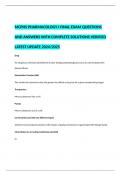Exam (elaborations)
MCPHS PHARMACOLOGY I FINAL EXAM QUESTIONS AND ANSWERS WITH COMPLETE SOLUTIONS VERIFIED LATEST UPDATE 2024/2025
- Course
- Institution
MCPHS PHARMACOLOGY I FINAL EXAM QUESTIONS AND ANSWERS WITH COMPLETE SOLUTIONS VERIFIED LATEST UPDATE 2024/2025 Drug An exogenous chemical administered to alter biological/physiological process to cure/treat/prevent disease/illness Dissociation Constant (Kd) The smaller the numerical value the g...
[Show more]



